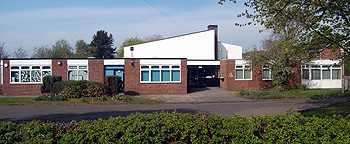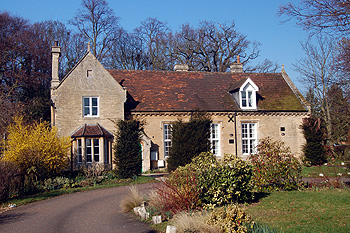Oakley School from 1903
![The school about 1900 [Z50-85-8]](/CommunityHistories/Oakley/OakleyImages/The school about 1900 [Z50-85-8].jpg)
The school about 1900 [Z50/85/8]
A land mark Education Act was passed in 1902, coming into effect in 1903. It disbanded the School Boards and gave day to day running of education to newly formed Local Education Authorities, usually the county council, as in Bedfordshire. Thus Oakley became a Council School.
Bedfordshire & Luton Archives & Records Service has a scrapbook of cuttings of visits made to most Bedfordshire Schools by School Inspectors for a period from just before the First World War through the inter-war years [E/IN1/1]. The first visit in the scrapbook was made in November 1911, when average attendance was 59. “This School continues to be carefully taught and in spite of sickness, which during part of the year greatly affected the attendance, the level of efficiency reached is decidedly creditable to the Head Mistress. Among which is commendable Physical Exercises and Hand and Eye Training deserve special mention”.
In October 1914 average attendance was 61: “The School continues to be carefully taught and the level of efficiency reached is creditable, though in Arithmetic the older children in the first class have not made the progress which might be expected considering the satisfactory work done by the younger children of this class. The tone of the School is decidedly good and the children are polite and well-behaved”.
The next inspection was not made until after the First World War – in November 1922, when average attendance was 42. “A new Head Teacher took charge of this school a year ago, and, as the teaching is stimulating and the children work earnestly prospects seem to be good”.
“Arithmetic is, at present, not a strong subject, and both History and Singing need more attention. The rest of the work, which reaches quite a creditable level, promises well for the future. The children behave well in school”.
“The Infants are carefully and suitably taught and are making good progress”.
The report for July 1925 was as follows. “This School is in very good order, and is making steady progress. The Infants’ Class is thoroughly well taught. The work of the older scholars – Standards I-VII – also is now good except the Writing and Composition of Standards V-VII, in which the aim should be higher, and some of the Drawing, Arithmetic, History and Singing, criticized in the last Report, have all much improved, and the Physical Training is very good indeed”. In June the following year the report was restricted to gardening, then an important part of the curriculum, which should have stood the country in good stead during World War Two when food had to be grown in back gardens: “The Mistress has had no special training in Gardening but she has good ideas about it, is keen, and is doing creditable work though of somewhat limited scope. Plots are clean, crops good, and practical operations well carried out. Tools should be more thoroughly cleaned and a rack is needed for their storage”.
![A Class at Oakley School in 1929 [Z50/85/11]](/CommunityHistories/Oakley/OakleyImages/A Class at Oakley School in 1929 [Z50-85-11].jpg)
A Class at Oakley School in 1929 [Z50/85/11]
The report for 1930 was glowing: “This is a good school and one that is a pleasure to visit. The children are well behaved and the character training they receive is excellent. The upper scholars are taught to work by themselves and they concentrate on their work when so engaged. The good result of this was seen in the large amount of information some of them were able to extract from the silent reading of a previously unseen passage”.
“In oral subjects the work attempted is well done, but the inspection showed that certain aspects of these subjects which are generally considered essentials, especially by the general public, are in danger of being omitted by some children when they are taken only once in three years. The Head Mistress saw this, and proposes to rectify it”.
“Some work calls for special praise: - Physical Exercises, Singing, Drawing and Handwork in a variety of forms. Neatness and even delicacy is a feature of the last two”.
“The Infants’ section is doing good work and the children are making satisfactory progress”.
The next inspection came in July 1934, when average attendance was 59. “This excellent little school, which has, at the end of this week, 62 on the roll, is conducted in two light and airy rooms whose relative sizes create some difficulty in the problem of staffing. In the smaller room is a Supplementary Teacher who is unusually skilful in the grounding on the Infants and Standard I in the 3 R’s. She has 20 children on the roll: the experiment earlier in the year of the inclusion of a Standard II, cramped the space available, and proved a little beyond the teacher’s power: the ground work suffered as attention was necessary for the extra group. So the Head Teacher has 42 in 6 different Standards in a room where two teachers would be rather close together. It could, however, be managed”.
“The work done is very thorough, neat, careful, well finished, and, in Speech work, Drawing and Song, refined in character. There is, at present a preponderance of senior children – 20 over 12 years old were present this morning, of whom 4 leave this year. It would be possible, with an additional teacher, to go more deeply into the literary side of the English with advantage to the type of children who attend here. The Head Mistress has done her best in the circumstances and may be congratulated on the condition of the school, the result of unremitting hard work on her part”.
The final report in the scrapbook dates to November 1938. “There are now only 44 children in this school – when the last report was written in July 1934 there were 62”.
“The school continues to be an outstandingly good example of its type. Every branch of its work will bear close inspection and it is difficult to elect any particular subject for special mention. The fall in the size of the classes has made it possible for the Head Mistress to give effective attention to the suggestion offered in the last report regarding the teaching of English”.
“The Infants, in charge of a Supplementary teacher, are competently trained and taught”.
During the Second World War children from Mora Road Infants School in Willesden [Middlesex] were evacuated to Oakley. The evacuated classes were taught in the morning and the Oakley children in the afternoon. In October the evacuees started to use the chapel school room as a full time school. In 1943 the two schools were again combined on the school site.
School routines were disrupted as the following [SDOakley1/3] shows:
- 23rd July 1940: "School re-opened this morning, 48 children present. During the closure, both porches have been converted into refuge rooms and all glass in windows and screen has been made splinter proof. The children were instructed in the use of these rooms and a simple Air Raid Drill was taken. Respirators were examined and worn for 15 mins this afternoon".
- 23rd July 1942: "Air Raid warning received from warden, at 8:57 am. Children assembled in shelters. All clear received at 9:15 am. Sirens not heard. Bombs dropped in Bedford". These bombs fell on the Grafton Hotel, Midland Road and Ashburnham Road. They came from a lone Dornier 17. A much more serious raid on Bedford on the night of 30th July that year killed ten people.
New activities were also added. The log book [SDOakley1/3] lists: "15th July 1941: Rabbit keeping has been commenced as an assistance to wartime food production".
The third of the great Education Acts was that of 1944 which established the principle of County Primary Schools for children up to the age of 11, at which time they took an examination to determine the nature of the secondary school they would attend until they were 15, the most academically able going to grammar schools, the rest to secondary or secondary modern schools. Oakley Council School thus became Oakley County Primary School.

Oakley Lower School April 2011
By the 1960s the old school building, dating from 1842, was increasingly unviable. It was thus decided to build a new school at the same time as the new Lincroft County Secondary Modern School was being built. The land for Lincroft School was conveyed in October 1962 [CCE1694/5] and it was decided to build the new county primary school on an adjoining site, the contract dating from 1962-1963 [CA2/60].
The old school building was listed by the former Department of Environment in August 1987 as Grade II, of special interest. The property, built of coursed limestone rubble with ashlar dressings and an old clay tile roof with bracketed eaves is now the community hall and hosts, among other things, the De Parys Medical Centre Drop in Service.
In the 1970s Bedfordshire County Council introduced comprehensive education, doing away with the 11+ examination and grammar schools and introducing a tier of school between the old County Primary and County Secondary Schools. Thus Lower Schools now taught children aged 4 to 9, Middle Schools from 9 to 13 and Upper Schools from 13 onwards. Oakley County Primary School thus became Oakley Lower School.
On 1st April 2009 Bedfordshire County Council was abolished. The new Local Education Authority for Oakley became Bedford Borough Council, formerly a district council but now a unitary authority. At the time of writing [2011] there is uncertainty over the future of the school structure in the Borough with a move to abolish middle school and have children go from a primary school to a secondary school at age 11.

The Community Hall March 2011